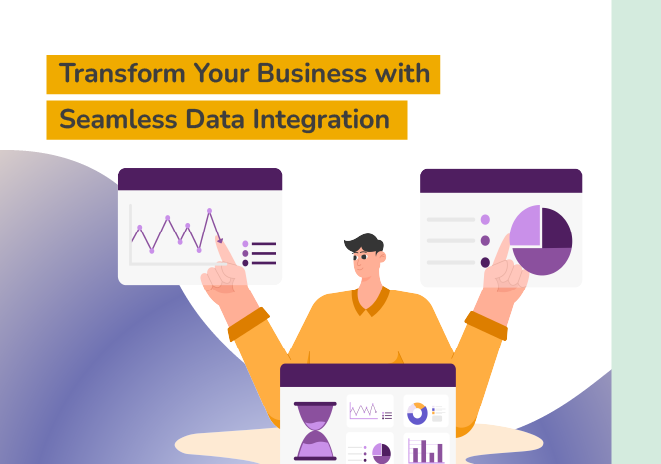What is seamless data integration?
Seamless data integration is the effortless process of consolidating data from various sources into a unified view, eliminating data silos and enabling smoother data flow. In a business context, it is crucial as it enhances operational efficiency, facilitates informed decision-making, and provides real-time insights. It involves using modern technologies and tools to ensure that data is continuously accessible and relevant, fostering agility and innovation.
Key Takeaways
- Seamless data integration is crucial for enhancing operational efficiency and decision-making.
- Seamless integration technologies like APIs, cloud-based platforms, and automation tools are essential for bridging data systems efficiently.
- Key challenges in data integration include data silos, security issues, and ensuring data quality.
- Measuring integration success involves tracking KPIs, evaluating operational improvements, and assessing the ROI from data initiatives.
Definition of data integration
Data integration refers to the process of combining data from various sources into a single, unified view. It is a crucial component in modern business operations as it enables organizations to harness the full potential of their data. Through seamless data integration, companies can ensure data consistency, enhance collaboration, and make more informed decisions, ultimately leading to increased efficiency and productivity.
Importance of seamless integration in business
In today’s
competitive landscape, seamless data integration is pivotal for businesses aiming to stay
agile and effective. By ensuring that disparate data systems communicate efficiently, businesses can enhance
insightfulness and
strategic decision-making. It facilitates
real-time access to critical information, boosting operational efficiency and enabling swift
adaptive measures. This interconnected approach not only
drives business innovation but also enhances the overall
customer experience and supports sustainable
growth and scalability.
Why is seamless data integration crucial for businesses?
Seamless data integration is vital for businesses as it
enhances decision-making,
improves operational efficiency, and enables
real-time data access. By integrating data seamlessly, organizations can unlock insights, streamline processes, and respond swiftly to market changes. This integrated approach leads to
better-informed strategies, and fosters a
collaborative working environment, ultimately facilitating
innovation and growth.
Enhancing decision-making processes
Seamless data integration plays a pivotal role in enhancing the decision-making processes within businesses. By ensuring
real-time access to integrated information, companies can leverage data to make informed decisions promptly. The integration eliminates
data silos, providing a holistic view that boosts
analysis accuracy and speeds up
response times. Additionally, seamless data integration offers improved
data consistency, which underpins strategic decisions, helping organizations adapt swiftly to market changes.
Improving operational efficiency
Implementing seamless data integration is pivotal for improving operational efficiency in businesses. By ensuring smooth data flow across various systems, companies can reduce downtime, eliminate redundancies, and streamline processes. This integration empowers employees to access necessary information quickly, enabling better resource management and cutting costs. Enhanced data accessibility allows for more responsive and agile operations, significantly boosting productivity and ensuring competitiveness in a fast-paced market.
Enabling real-time data access
Real-time data access is a fundamental component of
seamless data integration, enabling businesses to act swiftly and effectively in today’s fast-paced environment. By ensuring immediate availability of up-to-date information across all systems, companies can make informed decisions, respond to market changes, and enhance their
operational efficiency. This real-time capability not only boosts
productivity but also improves the overall
customer experience, ultimately driving business success.
How can seamless data integration transform your business?
Seamless data integration is crucial for transforming businesses by fostering
innovation and
growth. It enhances the
customer experience by ensuring consistent access to data across various platforms, leading to more personalized services. Additionally, it supports scalable
operations, allowing businesses to adapt quickly to market changes, which further boosts efficiency and productivity. By integrating data seamlessly, companies can build a solid foundation for more effective and informed
decision-making.
| Transformation Benefits |
Description |
| Innovation & Growth |
Fosters business advancement |
| Customer Experience |
Ensures consistent and personalized service |
| Scalable Operations |
Supports business adaptability and efficiency |
Driving innovation and growth
Seamless data integration serves as a catalyst for driving innovation and growth within businesses. By providing real-time access to integrated data, companies can make informed decisions, craft personalized customer experiences, and explore new market opportunities. Moreover, enhanced data integration empowers teams to identify and act on trends swiftly, leading to a competitive advantage and continuous business transformation.
Improving customer experience
Seamless data integration plays a pivotal role in enhancing customer experience by ensuring that businesses can access and utilize critical information in real-time. With integrated systems, organizations can gain a
360-degree view of customer data, allowing them to
anticipate needs and personalize interactions effectively. Streamlining data across platforms reduces response times and improves service delivery, ultimately fostering
customer loyalty and satisfaction.
Supporting scalable operations
Supporting scalable operations through
seamless data integration is pivotal for modern businesses aiming to expand efficiently. By unifying disparate data sources, companies can streamline processes, facilitate
real-time insights, and adapt swiftly to market demands. This
integration approach not only enhances flexibility but also strengthens the foundation for sustained growth. Implementing a robust data strategy helps cut costs, reduces operational complexities, and supports
innovative business models, fostering an environment where scalability is no longer a hurdle but a competitive advantage.
What are the key technologies for seamless data integration?
Seamless data integration is revolutionized by three pivotal technologies:
APIs and web services,
cloud-based integration platforms, and
automation tools. These technologies work in harmony to enable businesses to bridge disparate systems efficiently. APIs facilitate direct communication between applications, while cloud platforms offer scalable solutions that adapt to growing data demands. Meanwhile, automation tools simplify complex data processes, ensuring timely and accurate integration, ultimately enhancing overall business productivity.
APIs and web services
APIs and web services play a pivotal role in achieving seamless data integration, enabling systems and applications to communicate effortlessly. They facilitate the exchange of information across different platforms, breaking down data silos and enhancing operational efficiency. By implementing APIs, businesses can ensure real-time data access, crucial for driving innovation and delivering improved customer experiences. The flexibility and scalability of APIs make them essential tools for any modern integration strategy.
Cloud-based integration platforms
Cloud-based integration platforms are pivotal in achieving seamless data integration for businesses. These platforms provide a versatile and scalable environment, allowing companies to connect diverse data sources effortlessly. With the ability to streamline data flows and real-time data accessibility, cloud-based solutions empower businesses to enhance operational efficiency and drive innovation. Embracing these technologies is critical for modern enterprises seeking to stay competitive in an increasingly data-driven world.
Automation tools and processes
Automation tools and processes play a pivotal role in achieving seamless data integration by streamlining workflows, reducing human errors, and enhancing operational efficiency. These tools facilitate real-time data syncing and transformation, ensuring that businesses harness the full potential of their data. By automating repetitive tasks, companies can allocate resources to more strategic initiatives, driving innovation and business growth. Moreover, these solutions improve data governance and compliance, fostering a more organized and data-driven environment.
How to implement a seamless data integration strategy?
Implementing a seamless data integration strategy requires a thorough assessment of your current data architecture to identify gaps and opportunities. Choosing the right integration tools is essential to ensure compatibility and scalability. Careful planning of the integration process helps streamline operations and meets business objectives, balancing innovation with practical demands, while minimizing data silos and reducing complexity.
Assessing current data architecture
Assessing your current
data architecture is the first step towards achieving seamless data integration. Understanding your existing data flow, storage, and processing capabilities is crucial. It helps identify bottlenecks and inefficiencies, paving the way for streamlined integration. Conducting a thorough analysis will reveal gaps in data accessibility, which can hinder decision-making and operational efficiency. With this assessment, businesses can effectively plan their integration strategies to maximize returns and drive innovation.
Choosing the right integration tools
Choosing the right integration tools is paramount for businesses aiming to achieve seamless data integration. Selecting tools that align with your company’s goals can significantly enhance efficiency and agility. The right tools facilitate smooth communication between systems, enabling better data consistency and real-time access. It’s crucial to consider factors such as compatibility, scalability, and ease of use when selecting these tools. A well-chosen toolset can transform your data landscape, driving innovation and growth.
Planning the integration process
Planning the integration process is a crucial step in achieving seamless data integration for your business. It involves evaluating your current data infrastructure, selecting appropriate integration tools, and meticulously mapping out the integration journey. By laying out a strategic plan, businesses can mitigate potential disruptions, ensuring a smooth transition to integrated systems that enhance data accessibility and usability.
„Strategic planning in data integration is essential to minimize disruptions and realize the full potential of integrated systems.“
What are common challenges in seamless data integration?
Seamless
data integration poses several challenges that businesses must navigate to ensure effective implementation. One major hurdle includes dealing with data silos, which can prevent the easy flow and consolidation of information across systems. Additionally, maintaining
data security and compliance is crucial to protect sensitive business information. Companies also grapple with managing data quality and consistency to ensure reliable and accurate integration results, crucial for driving business success.
Dealing with data silos
Data silos present a significant challenge to seamless data integration, obstructing the free flow of information across an organization. These isolated data pools can lead to inefficiencies, duplication, and inconsistencies. Overcoming data silos is crucial for leveraging integrated data, ensuring cohesion, and maximizing operational efficiency. Effective strategies involve breaking down these barriers through robust integration tools and technologies, fostering collaboration, and encouraging data sharing across departments.
Ensuring data security and compliance
Ensuring data security and compliance is vital in seamless data integration to protect sensitive information and adhere to industry regulations. By integrating robust security protocols, businesses can safeguard data against breaches while maintaining compliance with legal standards. Effective data security involves implementing encryption, access controls, and regular audits to ensure comprehensive protection. Adhering to these practices ensures the integrity and trustworthiness of data systems, fostering a secure environment for data exchange.
| Aspect |
Importance |
| Data Security |
Protects sensitive information |
| Compliance |
Adheres to industry regulations |
| Encryption |
Safeguards data through encryption methods |
| Access Control |
Limits data access to authorized personnel |
| Regular Audits |
Ensures ongoing data protection adherence |
Managing data quality and consistency
Ensuring high-quality and consistent data is pivotal for successful
data integration. Poor data quality can lead to inaccurate insights and hinder business operations. Consistency across datasets ensures that all systems reflect the same information, fostering reliability. Implementing automated
data management tools can significantly help in maintaining both quality and consistency, further enabling
seamless integration for enhanced business performance.
How to measure the success of data integration?
Measuring the success of
data integration is vital for determining the return on investment and operational improvements. Key
performance indicators (KPIs) include evaluating the speed and efficiency of data processing, the accuracy of data-driven decision-making, and user satisfaction rates. Monitoring these metrics helps businesses understand the operational benefits and financial gains derived from seamless integration, ultimately ensuring that the integration strategy supports broader organizational goals.
- Performance Indicators: Evaluate data processing efficiency.
- Decision Accuracy: Measure impact on data-driven decisions.
- User Satisfaction: Assess satisfaction rates post-integration.
Key performance indicators
Key performance indicators (KPIs) play an essential role in measuring the success of seamless data integration efforts. They offer valuable insights into how effectively your business integrates and utilizes data across systems. By tracking KPIs such as data accuracy, speed of integration, and user accessibility, businesses can gauge their progress. Properly identified KPIs help to ensure alignment with strategic business goals and continuous improvement in data management practices.
Evaluating operational improvements
Evaluating operational improvements is vital in measuring the success of
seamless data integration strategies. Tracking key performance indicators (KPIs) is crucial, but it’s also important to assess the tangible improvements in your business operations. Are your processes more efficient? Is there a reduction in manual data handling? Understanding these factors helps you identify areas where your integration efforts are paying off, ensuring sustained success.
Measuring ROI from data initiatives
Measuring
ROI from data initiatives is essential for evaluating the success of
seamless data integration efforts. Businesses can track ROI by analyzing key
performance indicators such as increased revenue, enhanced customer satisfaction, and streamlined operations. By carefully assessing these metrics, organizations can identify the value generated through improved data processes, thereby making informed decisions about future investments and strategies.
Evaluating data-driven outcomes is crucial for sustaining competitive advantage.
FAQ
What is seamless data integration?
Seamless data integration is the effortless process of consolidating data from various sources into a unified view, enhancing operational efficiency and enabling smoother data flow.
Why is seamless data integration crucial for businesses?
It enhances decision-making, improves operational efficiency, and enables real-time data access, ultimately driving innovation and growth.
What are the key technologies for achieving seamless data integration?
Key technologies include APIs and web services, cloud-based integration platforms, and automation tools, which streamline systems communication and enhance productivity.
How can seamless data integration transform your business?
It fosters innovation and growth, enhances the customer experience, and supports scalable operations, allowing businesses to adapt swiftly to market changes.
What are common challenges in seamless data integration?
Challenges include dealing with data silos, ensuring data security and compliance, and managing data quality and consistency.









